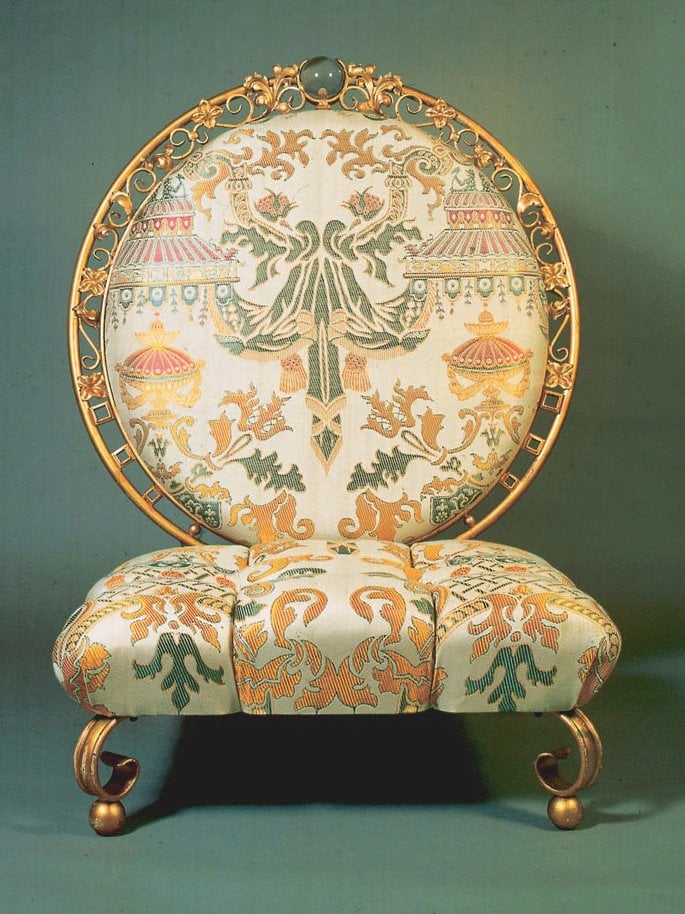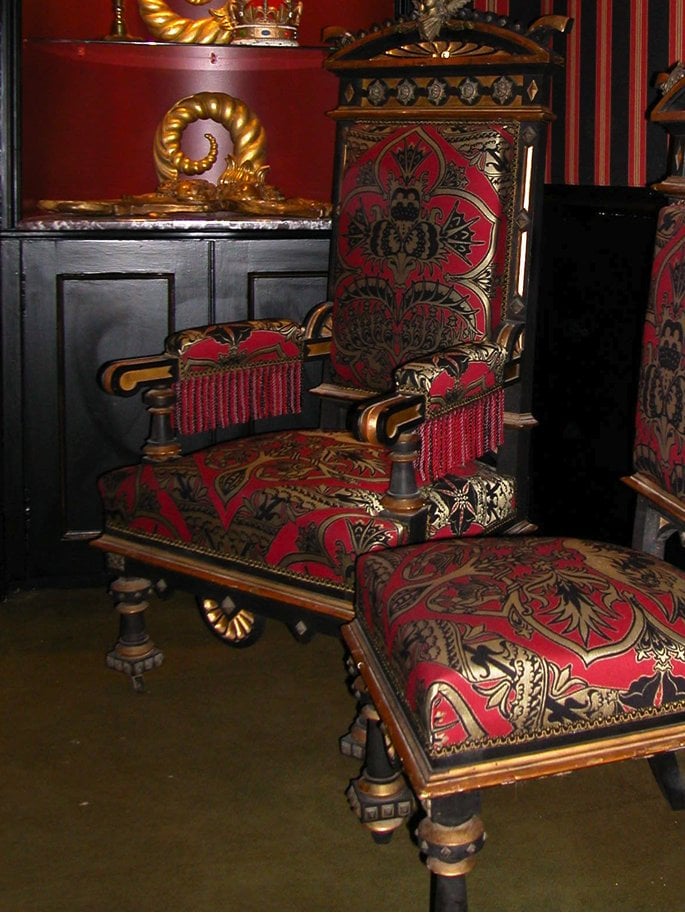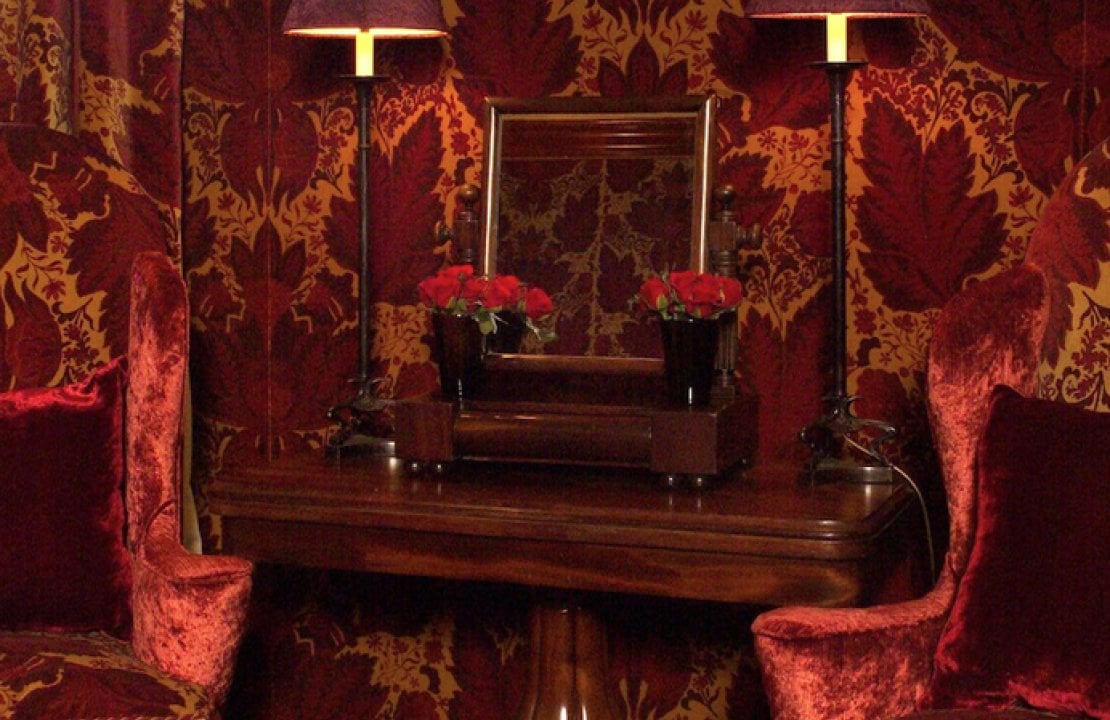Brocade, Brocatelle, Chenille, Chintz, Damask, Linen, Tapestry, Tartan, Tweed, Velvet, Weaves, Wools to name but a few. There are so many fabulous fabrics; sometimes it’s overwhelming choosing the right one.
Although I will be talking about some practical considerations when selecting fabric, my intuitive choice is usually the right one. Love the fabric you choose. Upholstery is a hard craft; all that effort needs the perfect top fabric.
At the beginning of your project, it’s worthwhile looking at the existing fabric on your furniture. There are usually practical reasons why that fabric has been chosen. For example, on extreme mid-century curves, a fabric with a bit of stretch can help. For dining chairs, a robust fabric that has been scotch-guarded would be advisable. Is there a lot of machine sewing or hand sewing? If there are deep buttons, how do you want the folds to look? Cotton gives flat, crisp folds whilst velvet gives a more relaxed look. Textured fabrics tend to soften angles while others accentuate.

Fabric prices range from £20 to several £100s per metre, which is quite a dramatic difference. Like most things in life, you get what you pay for. The thinner the fabric, the harder it’ll be to work with and you may be disappointed with the result. In my experience, the top of the range fabrics generally have the most amazing prints and patterns, so if you want a ‘show-stopper’ you may need to prepare yourself. Personally, my workable range is £40-£100 a metre. Most fabric I fall in love with is within this bracket.
Martindale
Check how hardwearing the fabric is. Upholstery fabric is designed to be relatively durable and is graded from Light Domestic to Severe Contract use. The Martindale, also know as the rub test, machine rubs the fabric to check it’s wear and tear. Light Domestic is 13-15,000 rubs, whereas Severe Contract is 75,000 rubs and above. For a chair or sofa in your home, I’d look for a fabric with a rub test of 25,000 or above.

What Fire Regulations should I be aware of?
As a professional upholsterer, I always have to comply with the current fire regulations. It’s worth knowing the fundamentals so you can make the best decision for your safety.
A piece of furniture made from 1950 to the present day must comply with the current fire regulations. This means all upholstery materials and top fabric must be FR treated. A lot of fabrics do not meet FR standards but you can usually get them back sprayed when buying. Even antiques will need fire retardant fabric if they have modern upholstery within them, such as foam and polyester wadding.
Velvets don’t work so well with spraying, as damage can be caused in the process. If the fabric is 75% natural fibres or above, an FR interliner can be used underneath the fabric, to bring it up to fire regulations. There are also different levels of FR depending on usage; FR for domestic upholstery isn’t required to be as rigorous as for commercial work.
What is Railroading and why does it matter?
A fabric roll width is usually 140cm wide. A pattern fabric tends to run ‘up the roll’, top to bottom, parallel with the selvedges. If you need to cover a large area without a seam, for example on a sofa or chaise longue, you can turn the fabric 90 degrees. Thus working with the pattern along the length rather than the width. This is called railroading. However, the light can affect the fabric nap, especially on velvet, so railroading doesn’t always work and of course, a lot of patterns cannot be turned either.

Pattern repeat
A large pattern repeat can mean buying a lot of fabric for pattern matching. Consider this if the repeat is larger than 20cm. Large patterns look dramatic and striking but take into account the size and details of the furniture. You don’t want to see half a pattern throughout a chair.
Small patterns add interest and hide any stains. I would avoid Tartan or check on very curvy pieces. I also try to avoid large patterns on deep-button furniture; the pattern gets too distorted for my liking!
Finally, if you are going for a check or a tartan, make sure the pattern is balanced. I work from the middle outwards. Imagine a vertical line in the middle of the chair or sofa; either side of the line should be symmetrical.
Colour
I always look at the show wood first, as it’s nice to have a contrast in tones. Try not to pick too dark a fabric if the wood is dark. Light in a room effects colour as well, so make sure the colour works in your room. What looks good in a showroom might not translate in your home. Choosing a colour can be very subjective and can affect your emotional state. We all have our favourite colours; use your instinct and experiment with colour combinations.
Fabric types
Fabric can be made with natural or man-made fibres. Mixing them together can get great results in terms of creasing, softness and durability. When choosing your fabric consider how pliable it is, loose weaves aren’t good when stretched.
100% wool fabrics can be itchy and the moths love them. A wool mix would always be my preference. I have to admit; my heart sinks when I have to machine sew faux leather. The fabric can split when sewing back on the machine, to finish and end a line, and you get one shot sewing, as the needle holes don’t disappear.

Velvet is very popular. 100% cotton velvet is soft and luxurious but can mark very easily. Consider this if you are using it on a chair or sofa that is being used heavily. Having said that, there are some fantastic polyester mixes now, which don’t mark and also don’t have the ‘sheen’, which tends to exist on cheaper velvets. Velvet also stretches and ripples when machine sewn. It unfortunately takes a lot of experience to sew velvet perfectly.
You’ll learn something new from every project you do, which is the joy of upholstery. Hopefully these tips will give you the confidence to pick the perfect fabric for your project!
Can you use curtain fabric for upholstery?
The short answer is no. If you use fabric for upholstery that is not specifically described as being suitable for upholstery, it will not produce a good result. It may stretch and distort when pulled over chair seats and backs and sofas and also wear and age very quickly when sat upon on a regular basis. Only use fabric described as being suitable for upholstery for recovering your chairs and sofas.
This article has been written for us by an old friend of The Victorian Emporium, Claire Platten, who is a fabulous upholsterer based in East London.
Claire Platten studied Fine Art at University, had a successful career in marketing and graphic design before re-training as an upholsterer. Whilst working on furniture commissions, Claire also works on her own collections. Working with modern and traditional techniques, Claire puts her experience with design, colour and craft to produce unique pieces of furniture.
Claire@claireplatten.com
www.claireplatten.com

Be the first to add a comment...